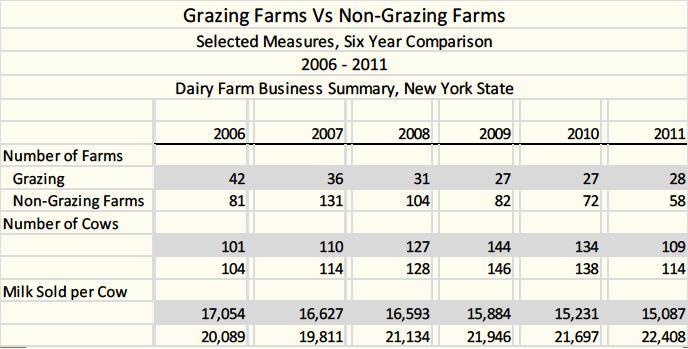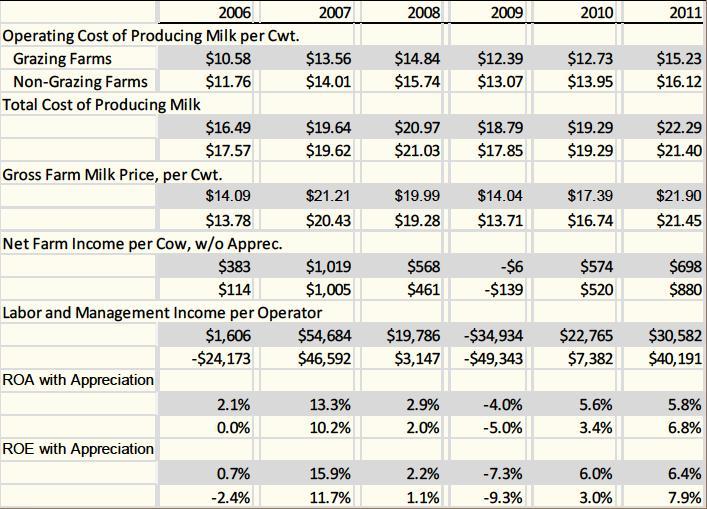2013 Northeast Pasture Consortium Annual Meeting Northeast Pasture Research and Extension Consortium 2016 Annual Meeting, Manchester, NH, February 6-7, 2013
After lunch recess, Session 3, Economics of Confinement Dairy Farms versus Pasture Dairy Farms, began at 1:30 PM. Jim Cropper introduced Jason Karszes, Senior Extension Associate, Cornell University Dairy Farm Business Management Program.
Jason Karszes’ presentation looked at the session’s title from the perspective of a business analyst. He gave some background on the Dairy Farm Business Summary (DFBS) that analyzes dairy farm financial statements. It began in 1955. It compiles consolidated dairy farm financial statements. It tracks business performance over time. It has produced a separate grazing publication since 1996.
Each year DFBS compares grazing performance to non-grazing performance. Grazing has been consistently better than confinement dairy farms. However, the spread has been shrinking. 2011 was the first year since the project started that non-grazing dairies out-performed grazing dairies. What may be occurring? Perhaps it is the change in farms participating in DFBS.
Another possibility is changing weather patterns during the growing season restricted pasture production so that stored forage and other feeds had to be fed instead. Grazing dairies are more vulnerable to weather extremes than confinement dairies.
It could be rising input costs. Milk price variability may also be playing a role, especially when prices are depressed since pasture dairies produce less milk per cow and enterprise than confinement dairies. When prices are down, volume has to go up to maintain cash flow.
Investment costs may also play a role, especially for new entrants. The financial statements only lead you so far. Care has to be taken not make assumptions as to why things turn out as they do based on the statements. A deeper look into each dairy and the particular year would be needed to ascertain why the financial statement turned out the way it did.
Key Areas of Difference between a pasture-based dairy farm and a
confinement dairy farm are:
- The pasture-based dairy farm has less tillable land base
- Lower milk per cow
- Higher cows per worker
- Lower investment per cow
- Lower grain costs
- Lower total operating costs, and
- Higher milk price.

The most striking data set from the six years of data from 2006 to 2011 above is the milk sold per cow. Pasture-based dairy farms reporting in the DFBS had a decline in milk produced per cow of 1967 pounds in annual milk production from 2006 to 2011. Meanwhile, the confinement dairies produced 2319 pounds more milk per cow per year in 2011 versus 2006. Comparing total milk produced per cow per year, the pasture-based dairies produced only a farm average of 15,087 pounds versus the confinement dairies farm average of 22,408.
The pasture-based dairy farms are only producing 67 percent of the milk per cow per year than the confinement dairy farms in the study are producing. Their costs have to be extremely low and/or price received for milk sold much higher than that received by the confinement dairy farm.
Unfortunately when the table below is looked at and comparisons made for total cost of producing milk and price received for milk per hundredweight between grazing farms and non-grazing farms, this simply did not occur in 2011. Total cost of producing milk was nearly a dollar more per hundredweight for the grazing farms versus the non-grazing farms. Milk price received per hundredweight was only 45 cents or 2 percent more.

There have been some significant shifts in the dynamics of running a dairy farm since Jason last reported to the Consortium in 2010. Input costs are changing especially as it relates to feed concentrates, and particularly organic grains. It is getting cheaper for a farmer to raise his own grain rather than buying it. This is dramatically different than a few years ago when grain could be purchased for much less than producing your own on a relatively small scale to that of a cash grain farmer.
The other input cost that has soared is diesel fuel that powers tractors on farms. This is more of an issue with confinement dairies than with pasture dairies. Fuel use can be considerably lower on pasture dairies since less conserved forage is harvested with machinery.
Jason presented the Profitability Equation. This can help in understanding how to increase profitability.
Profitability = Volume x (Price - Cost) / Investment
There are only four ways to increase profitability:
- Volume
- Price
- Cost
- Investment
As milk production has decreased on grazing farms,
- What have costs done?
- What has investment done?
- What has price done?
- How are the farms getting better?
- What do they do next?
Volume can be changed by producing more milk per cow. The trend of declining milk produced per cow on grazing dairy farms in the DFBS needs to be reversed. Is this a feeding ration problem or a genetics problem? Or both? Weather related? Price is not easily changed by the producer so it is essentially not controllable. Switching to organic milk production might be an option.
However, costs may increase. Costs can be decreased by being frugal, but commodity prices like grain and diesel fuel are again controlled by someone else. They can be used less, but this is likely to hurt milk production (volume). Investment can be less with grazing since equipment needs and storage facilities can be less. However, shorting on truly needed investments may again hurt milk production (volume).
Jason wrapped up his presentation by posing a series of thought-provoking questions. Each pasture-based dairy operator needs to answer these questions in the context of their own operation.
Questions being asked:
- What should milk production be?
- How should it be measured?
- Per Cow
- Per Acre
- Components
- Can costs be lowered faster than decrease in income from lower milk production?
- How do we offset investment costs?
- How do we offset inflation?
- Better vs bigger; better manage what you have now; bigger may be harder to manage well.
- If bigger, how? Better milking facility? Enough existing or potential pasture land?
- How to minimize impact of no (not enough anyway) grass at times
during the grazing season?
- Irrigation?
- More stored feeds?
- Confinement feedings systems?
- More cropping operations (e.g. produce on-farm concentrates)?
After Jason, Wally and Eric Sheffer, Sheffer’s Grassland Dairy, Hoosic Fall, NY gave a pasture-based dairyman’s perspective on the profitability of stocking lactating dairy cows on pasture. Wally and Eric are a father and son team. After Eric graduated from Cornell University in 2007 with an animal science degree, he decided to come back to the farm and setup a dairy.
Up to this time, Wally had been raising dairy heifers. Wally guided Eric towards rotational grazing. Knowing their land was best suited to grazing, father and son attended grazier meetings together in the 1990’s to see how others made grazing systems work. They built a double-12 swing parlor and holding area, using logged wood and sawmill at Sheffer’s Grassland Dairy, during the winter of 2007-08. One hundred and eight-eight milk cows were stocked on 215 acres of pasture in 2012.
In 2013, they plan to expand to a milk cowherd of 200. An additional 30 acres of more pasture will be available in 2013 to meet the needs of the expanded herd. Calves are group fed on a nipple barrel. So far, they have only lost one calf since initiating group feeding. Pasture yields have risen from 2.5 tons per acre to 4.0 tons per acre as they have improved their pastures with red and white clover and orchardgrass seedings. They are also using perennial ryegrass. They have been trying to eradicate fescue since it is not dairy cow forage.
Eric while at Cornell had the opportunity to study New Zealand style grazing management. He attended a semester exchange program at the University of Lincoln in New Zealand. He took a grazing course at the college that presented comprehensive, detailed information on all aspects of grazing. He also had the opportunity to travel to NZ dairy farms. By talking with the NZ dairy farmers, he got the proper mindset to run a low-input dairy and be really efficient. The grass farm lifestyle also suited him.
They plan to expand to 300 cows eventually. They use the tools, the Dairy Farm Business Summary that Jason Karszes presented and the Dairy Profit Monitor, to help measure and monitor performance and progress. It is obvious that they are using the Profitability Equation and making volume, cost control, and shrewd investments work.